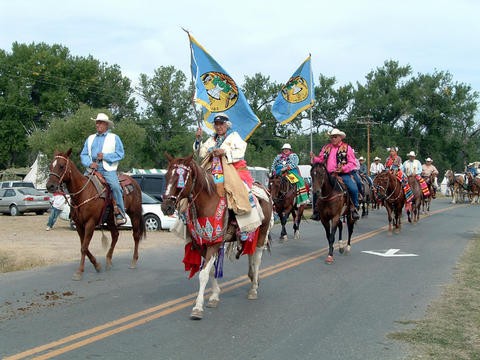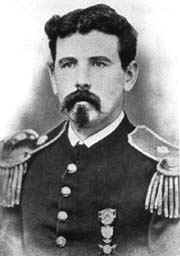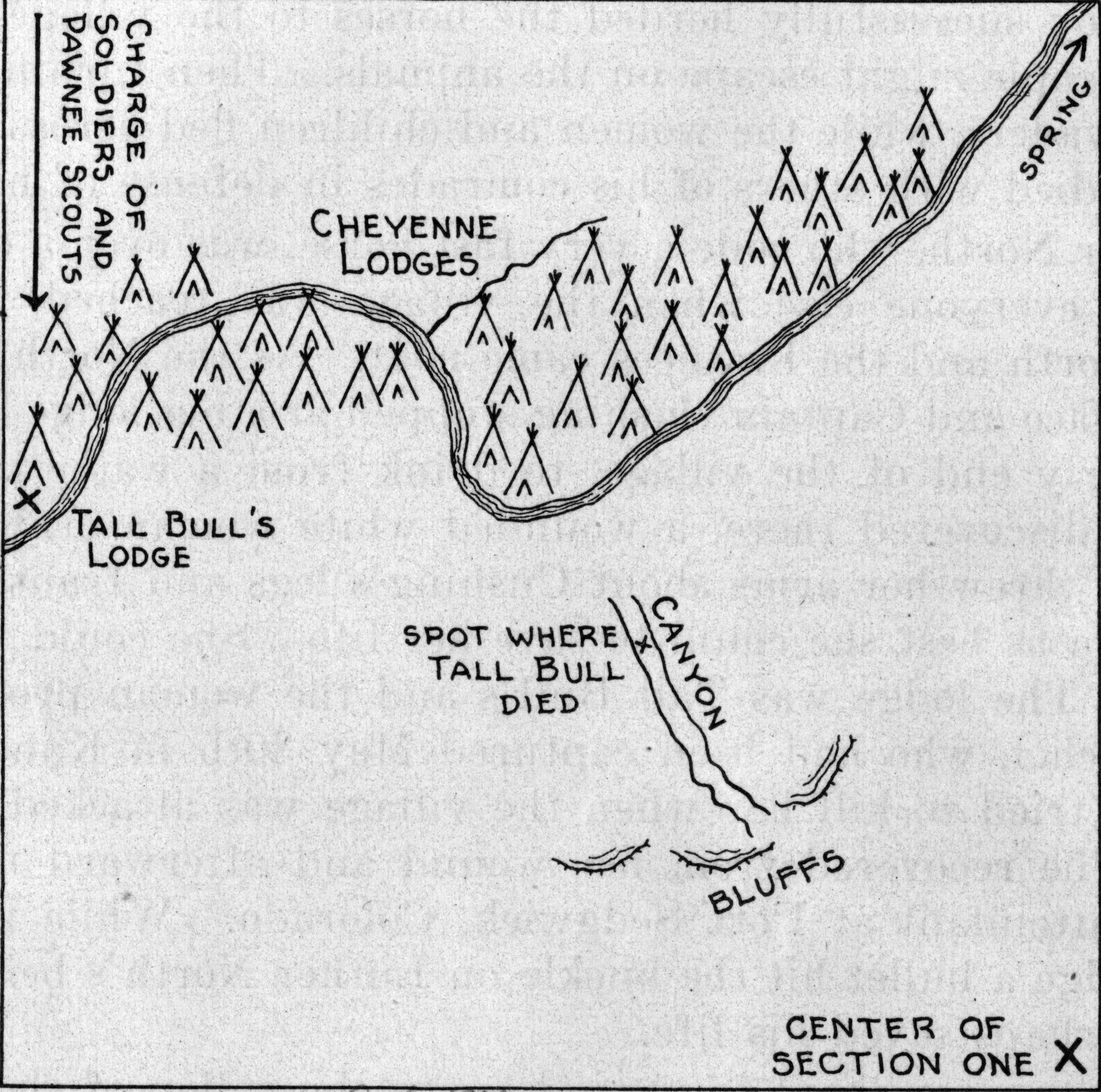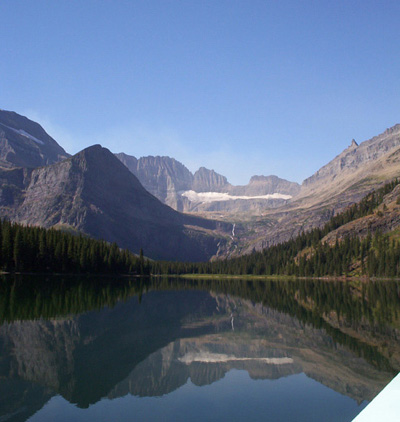|
Dog Rope
A dog rope is a short length of rawhide rope that was used by the Dog Soldiers of the Cheyenne warrior societies and warriors considered especially brave of other tribes. Its purpose was to anchor the warrior in place when a last-ditch defence was called for, thus indicating an intention not to retreat even against overwhelming odds. Construction The dog rope consisted of eight to twelve feet of rawhide around four inches wide. One end of the rope was tied to a picket pin (a pin that could be hammered into the ground, normally used for fixing the picket rope of a horse) by a string. The rope was usually carried wound over the right shoulder and under the left arm. It was looped through a slit cut in the free end to secure it to the wearer. It could also be hung from the belt by a string. The leather of the rope was decorated with feathers and porcupine quills dyed bright colours. The picket pin was made of wood and painted red. Beadwork, although a common Native Amer ... [...More Info...] [...Related Items...] OR: [Wikipedia] [Google] [Baidu] |
Rawhide (material)
Rawhide is a hide or animal skin that has not been exposed to tanning. It is similar to parchment, much lighter in color than leather made by traditional vegetable tanning. Rawhide is more susceptible to water than leather, and it quickly softens and stretches if left wet unless well waterproofed. "Rawhide" laces often sold for boots or baseball gloves are made of normal tanned leather rather than actual rawhide. Rawhide is not pliable when dry and would be unsuitable for that use. Process The skin from buffalo, deer, elk or cattle from which most rawhide originates is prepared by removing all fur, meat and fat. The hide is then usually stretched over a frame before being dried. The resulting material is hard and translucent. It can be shaped by rewetting and forming before being allowed to thoroughly re-dry. It can be rendered more pliable by 'working', i.e. bending repeatedly in multiple directions, often by rubbing it over a post, sometimes traditionally by chewing. It may ... [...More Info...] [...Related Items...] OR: [Wikipedia] [Google] [Baidu] |
Crow Nation
The Crow, whose Exonym and endonym, autonym is Apsáalooke (), also spelled Absaroka, are Native Americans in the United States, Native Americans living primarily in southern Montana. Today, the Crow people have a federally recognized tribe, the Crow Tribe of Montana, with an Indian reservation located in the south-central part of the state. Crow Indians are a Plains tribe, who speak the Crow language, part of the Missouri River Valley branch of Siouan languages. Of the 14,000 enrolled tribal members, an estimated 3,000 spoke the Crow language in 2007. During the expansion into the West, the Crow Nation was allied with the United States against its neighbors and rivals, the Sioux and Cheyenne. In historical times, the Crow lived in the Yellowstone River valley, which extends from present-day Wyoming, through Montana and into North Dakota, where it joins the Missouri River. Since the 19th century, Crow people have been concentrated on their reservation established south of Bill ... [...More Info...] [...Related Items...] OR: [Wikipedia] [Google] [Baidu] |
Thomas B
Thomas Browne Henry (November 7, 1907 – June 30, 1980) was an American character actor known for many guest appearances on television and in films. He was active with the Pasadena Community Playhouse and was the older brother of actor William Henry. Selected filmography * ''Hollow Triumph'' (1948) - Rocky Stansyck (uncredited) * '' Behind Locked Doors'' (1948) - Dr. Clifford Porter * ''Sealed Verdict'' (1948) - Briefing JAG colonel * ''Joan of Arc'' (1948) - Captain Raoul de Gaucort * ''He Walked by Night'' (1948) - Dunning (uncredited) * ''Impact'' (1949) - Walter's Business Assistant (uncredited) * ''Tulsa'' (1949) - Mr. Winslow (uncredited) * ''Johnny Allegro'' (1949) - Frank (uncredited) * ''House of Strangers'' (1949) - Judge (uncredited) * '' Special Agent'' (1949) - Detective Benton (uncredited) * '' Flaming Fury'' (1949) - Robert J. McManus (uncredited) * '' Post Office Investigator'' (1949) - Lt. Contreras * '' Bagdad'' (1949) - Elder (uncredited) * '' Underto ... [...More Info...] [...Related Items...] OR: [Wikipedia] [Google] [Baidu] |
George E
George may refer to: People * George (given name) * George (surname) * George (singer), American-Canadian singer George Nozuka, known by the mononym George * George Washington, First President of the United States * George W. Bush, 43rd President of the United States * George H. W. Bush, 41st President of the United States * George V, King of Great Britain, Ireland, the British Dominions and Emperor of India from 1910-1936 * George VI, King of Great Britain, Ireland, the British Dominions and Emperor of India from 1936-1952 * Prince George of Wales * George Papagheorghe also known as Jorge / GEØRGE * George, stage name of Giorgio Moroder * George Harrison, an English musician and singer-songwriter Places South Africa * George, Western Cape ** George Airport United States * George, Iowa * George, Missouri * George, Washington * George County, Mississippi * George Air Force Base, a former U.S. Air Force base located in California Characters * George (Peppa Pig), a 2-year-ol ... [...More Info...] [...Related Items...] OR: [Wikipedia] [Google] [Baidu] |
Fort Keogh
Fort Keogh is a former United States Army post located at the western edge of modern Miles City, Montana, Miles City, in the U.S. state of Montana. It is situated on the south bank of the Yellowstone River, at the mouth of the Tongue River (Montana), Tongue River. Colonel Nelson A. Miles, commanding the 5th Infantry Regiment (United States), 5th Infantry Regiment, founded the post in August 1876, in the wake of the Battle of the Little Bighorn, as a base for patrols to prevent the Cheyenne and Sioux involved in the battle from escaping to Canada. The fort was originally known as the Tongue River Cantonment for two years. When relocated one mile west in 1878, it was renamed Fort Keogh in honor of Captain Myles Keogh, who was killed at the Little Bighorn. In 1877, the fort became the headquarters for the newly created District of the Yellowstone (a sub-unit of the Department of Dakota), which was commanded by Miles. The development of Fort Keogh as a military installation soon stimu ... [...More Info...] [...Related Items...] OR: [Wikipedia] [Google] [Baidu] |
Battle Of Summit Springs
The Battle of Summit Springs, on July 11, 1869, was an armed conflict between elements of the United States Army under the command of Colonel Eugene A. Carr and a group of Cheyenne Dog Soldiers led by Tall Bull, who was killed during the engagement. The US forces were assigned to retaliate for a series of raids in north-central Kansas by Chief Tall Bull's Dog Soldiers band of the Cheyenne. The battle happened south of Sterling, Colorado in Washington County near the Logan/Washington county line. Battle After Pawnee Scouts under Major Frank North led his command to Tall Bull's village, Colonel Carr, a veteran campaigner known as "The Black-Bearded Cossack", deployed his forces carefully so that they hit the unsuspecting camp from three sides at once. He had 244 men of the 5th United States Regiment of Cavalry and 50 Pawnee Scouts.Berthrong, p. 343 Captain Luther North of the Pawnee Scout Battalion related this incident in the book ''Man of the Plains'': About a half mile fro ... [...More Info...] [...Related Items...] OR: [Wikipedia] [Google] [Baidu] |
Warbonnet
A modern-day dog soldier wearing a feathered headdress during a pow wow at the Indian Summer festival in Henry Maier Festival Park, Milwaukee, Wisconsin. 2008. War bonnets (also called warbonnets or headdresses) are featherwork, feathered headgear traditionally worn by male leaders of the American Plains Indians Nations who have earned a place of great respect in their tribe. Originally they were sometimes worn into battle, but they are now primarily used for ceremonial occasions. In the Native American and First Nations communities that traditionally have these items of regalia, they are seen as items of great spiritual and political importance, only to be worn by those who have earned the right and honour through formal recognition by their people.'' Life of George Bent: Written From His Letters'', by George E. Hyde, edited by Savoie Lottinville, University of Oklahoma Press (1968), hardcover, 390 pages; trade paperback, 280 pages (March 1983), pp 214, 216, 239, 307. , .''The Ba ... [...More Info...] [...Related Items...] OR: [Wikipedia] [Google] [Baidu] |
Tall Bull
Tall Bull (1830 - July 11, 1869) (''Hotóa'ôxháa'êstaestse'') was a chief of the Cheyenne Dog Soldiers. Of Cheyenne and Lakota parentage, like some of the other Dog Soldiers by that time, he identified as Cheyenne.Hyde 1968, p. 339. He was shot and killed in the Battle of Summit Springs in Colorado by Major Frank North, leader of the Pawnee Scouts. Leadership Tall Bull was a major Southern Cheyenne Chief, war chief and Dog Soldier leader. In 1864, under his leadership he had approximately 500 people following him in the eastern Colorado and western Kansas and Nebraska area. He participated in the 1864-65 Arapaho-Cheyenne War, the retaliation that followed the Sand Creek massacre, but gave up the fight after seeing the futility of winning the war. In 1868, he participated in the Beecher Island battle. During the battle he warned Roman Nose not to go into battle until he fixed his broken medicine and to do it quickly so that he could join the fight. During 1869, Tall Bull w ... [...More Info...] [...Related Items...] OR: [Wikipedia] [Google] [Baidu] |
George Bird Grinnell
George Bird Grinnell (September 20, 1849 – April 11, 1938) was an American anthropologist, historian, naturalist, and writer. Grinnell was born in Brooklyn, New York, and graduated from Yale University with a B.A. in 1870 and a Ph.D. in 1880. Originally specializing in zoology, he became a prominent early conservationist and student of Native American life. Grinnell has been recognized for his influence on public opinion and work on legislation to preserve the American bison. Mount Grinnell in Glacier National Park in Montana is named after Grinnell. Exploration and conservation Grinnell had extensive contact with the terrain, animals and Native Americans of the northern plains, starting with being part of the last great hunt of the Pawnee in 1872. He spent many years studying the natural history of the region. As a graduate student, he accompanied Lieutenant Colonel George Armstrong Custer’s 1874 Black Hills expedition as a naturalist. He declined a similar appointm ... [...More Info...] [...Related Items...] OR: [Wikipedia] [Google] [Baidu] |
Denver
Denver () is a consolidated city and county, the capital, and most populous city of the U.S. state of Colorado. Its population was 715,522 at the 2020 census, a 19.22% increase since 2010. It is the 19th-most populous city in the United States and the fifth most populous state capital. It is the principal city of the Denver–Aurora–Lakewood, CO Metropolitan Statistical Area and the first city of the Front Range Urban Corridor. Denver is located in the Western United States, in the South Platte River Valley on the western edge of the High Plains just east of the Front Range of the Rocky Mountains. Its downtown district is immediately east of the confluence of Cherry Creek and the South Platte River, approximately east of the foothills of the Rocky Mountains. It is named after James W. Denver, a governor of the Kansas Territory. It is nicknamed the ''Mile High City'' because its official elevation is exactly one mile () above sea level. The 105th meridian we ... [...More Info...] [...Related Items...] OR: [Wikipedia] [Google] [Baidu] |
Kiowa Creek (Colorado)
Kiowa Creek is a U.S. Geological Survey. National Hydrography Dataset high-resolution flowline dataThe National Map , accessed March 25, 2011 tributary that flows northeast into the South Platte River in Morgan County, Colorado near Orchard. The creek's source is in the Black Forest of El Paso County, northeast of Colorado Springs, Colorado. Kiowa Creek rises in the highlands of the Colorado Piedmont and is subject to occasional flash flood A flash flood is a rapid flooding of low-lying areas: washes, rivers, dry lakes and depressions. It may be caused by heavy rain associated with a severe thunderstorm, hurricane, or tropical storm, or by meltwater from ice or snow flowing o ...s. See also * List of rivers of Colorado References Rivers of El Paso County, Colorado Rivers of Morgan County, Colorado Rivers of Colorado Tributaries of the Platte River {{Colorado-river-stub ... [...More Info...] [...Related Items...] OR: [Wikipedia] [Google] [Baidu] |
Suhtai
The Cheyenne ( ) are an Indigenous people of the Great Plains. Their Cheyenne language belongs to the Algonquian language family. Today, the Cheyenne people are split into two federally recognized nations: the Southern Cheyenne, who are enrolled in the Cheyenne and Arapaho Tribes in Oklahoma, and the Northern Cheyenne, who are enrolled in the Northern Cheyenne Tribe of the Northern Cheyenne Indian Reservation in Montana. The Cheyenne comprise two Native American tribes, the Só'taeo'o or Só'taétaneo'o (more commonly spelled as Suhtai or Sutaio) and the Tsétsêhéstâhese (also spelled Tsitsistas, The term for the Cheyenne homeland is ''Tsiihistano''. Language The Cheyenne of Montana and Oklahoma speak the Cheyenne language, known as ''Tsêhésenêstsestôtse'' (common spelling: Tsisinstsistots). Approximately 800 people speak Cheyenne in Oklahoma. There are only a handful of vocabulary differences between the two locations. The Cheyenne alphabet contains 14 letters. The ... [...More Info...] [...Related Items...] OR: [Wikipedia] [Google] [Baidu] |





%2C_the_Indian_territories.jpg)
